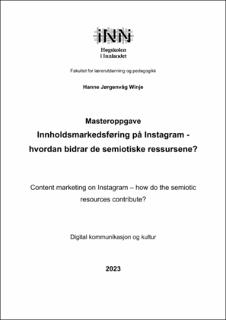Innholdsmarkedsføring på Instagram - hvordan bidrar de semiotiske ressursene?
Master thesis
Permanent lenke
https://hdl.handle.net/11250/3079819Utgivelsesdato
2023Metadata
Vis full innførselSammendrag
I denne studien skal jeg analysere hvordan semiotiske ressurser på Instagram samhandler med hverandre for så å skape verdi for en mottaker, og hvordan de til sammen bidrar til å skape innholdsmarkedsføring på Instagram. De semiotiske ressursene som analyseres er bilde, tekst og emoji. Instagram-kontoen som er valgt å hente analyserematerialet fra er Bama (@bamagruppen). Dette er interessant å se nærmere på blant annet fordi det i en undersøkelse publisert av Medietilsynet i 2021 kom frem at bare 32 % vet hva innholdsmarkedsføring er. I tillegg viste undersøkelsen at det kun er 42 % som klarer å skille mellom redaksjonelle og kommersielle saker (Medietilsynet, 2021). At så få vet hva innholdsmarkedsføring er, og at ikke flere klarer å skille mellom redaksjonelt og kommersielt stoff, gjorde at det vokste frem en interesse hos meg for å finne ut mer om dette. Jeg ønsket å finne ut mer om hva som gjorde at noe er innholdsmarkedsføring. Dette gjaldt spesielt på Instagram hvor det befinner seg en gråsone mellom det som er betalt innholdsmarkedsføring som skal merkes som reklame, og det som er innholdsmarkedsføring publisert på bedriftens eide flater. Med dette som bakgrunn ble følgende problemstilling utarbeidet: Hvordan bidrar de semiotiske ressursene til innholdsmarkedsføring på Bama sin Instagram-konto?
Gjennom en multimodal analyse av fem innlegg fra Bama sin Instagram-konto blir dette temaet belyst og drøftet. Dette gjøres gjennom å se nærmere på det visuelle, måten det visuelle forsøkes å formidles, samt mulig tolkning. Analysene deles inn i hva vi ser, hvordan det forsøkes å formidles, hvordan mottakeren skal forsøke å tolke budskapet og til slutt hvordan de semiotiske ressursene samhandler for å skape innholdsmarkedsføring. Funnene i analysen viser forskjellige måter de semiotiske ressursene samhandler og utfyller hverandre for å skape en mening for mottakeren som benyttes i Bama sin innholdsmarkedsføring. Til slutt i analysen rettes et kritisk blikk mot innholdsmarkedsføring, og den gråsonen mellom betalt og organisk innhold ofte befinner seg i på sosiale medier. Oppgaven avsluttes med forslag til videre forskning og noen punkter som belyser svakhetene i analysen. In this study I will analyze how the semiotic resources on Instagram interact with each other to create value for a recipient, and how they together contribute to creating content marketing on Instagram. The semiotic resources analyzed are images, text and emoji. The Instagram account chosen to collect the analysis material from is Bama (@bamagruppen). This is interesting to take a closer look at, among other things, because in a survey published by Medietilsynet in 2021, it emerged that only 32% know what content marketing is. In addition, the survey showed that only 42% are able to distinguish between editorial and commercial matters (Medietilsynet, 2021). The fact that so few know what content marketing is, and that not many are able to distinguish between editorial and commercial material, made me develop an interest in finding out more about this. I wanted to find out more about what makes something content marketing. This was especially relevant to Instagram, where there is a gray area between what is paid content marketing to be labeled as advertising, and what is content marketing published on the company's own platforms. With this in mind, I formulated the following question: How do the semiotic resources contribute to content marketing on Bama's Instagram account?
Through a multimodal analysis of five posts from Bama's Instagram account, this topic is thoroughly reviewed and discussed. This is done by taking a closer look at the visuals, the way the visuals are conveyed and the interpretation. The analyzes are divided into what we see, how it is tried to be mediated, how the recipient should try to interpret the message and finally how the semiotic resources interact to create content marketing. The results from the different analysis show different ways in which the semiotic resources interact and complement each other to create a meaning for the recipient that is used in Bama's content marketing. Finally, the analysis takes a critical look at content marketing and the gray area between paid and organic content that social media often finds itself in. The paper ends with some suggestions for further research, and also some points that highlight the weaknesses in the analysis.
